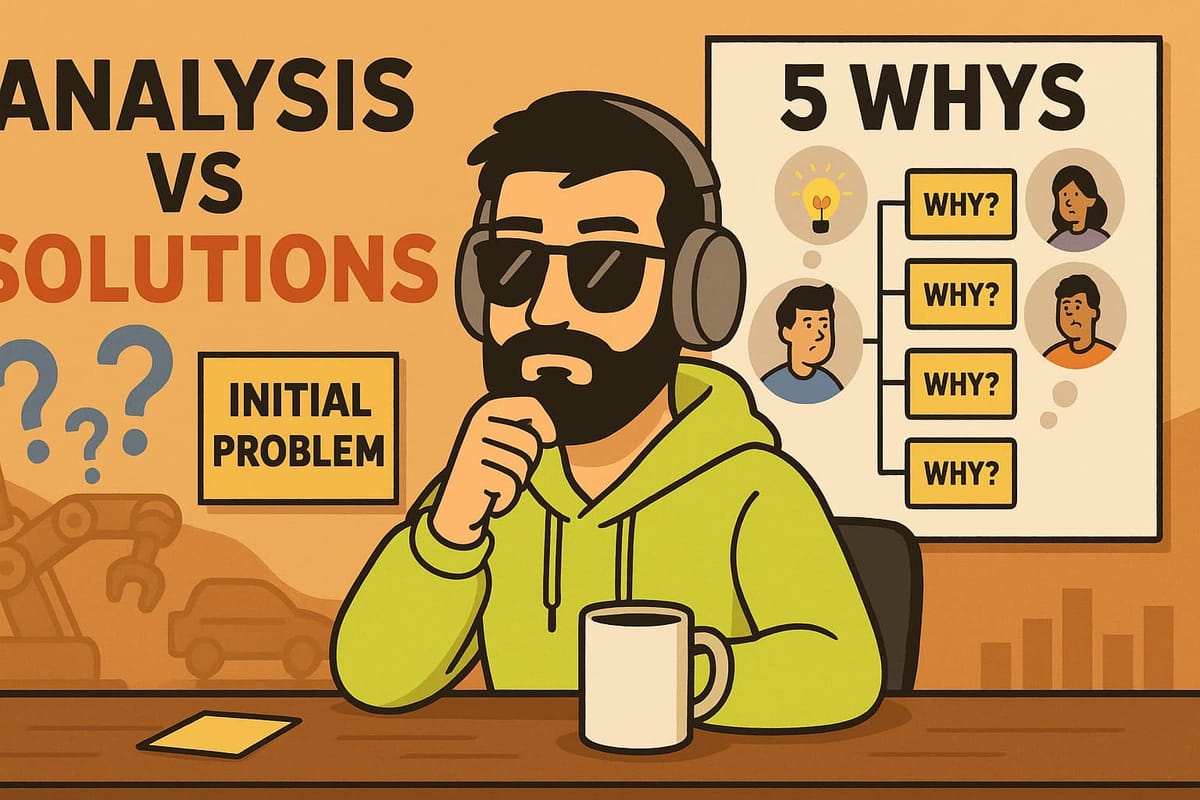Analysis vs Solutions: Using the 5 Whys for Root Cause Discovery

In a recent retrospective, my team and I struggled to solve a recurring issue. It became clear that we were missing the root cause of the problem, and our usual methods weren’t getting us there. To tackle this, we decided to take a different approach, diving deeper into the issue using the 5 Whys technique.
The Art of Thinking
We often split our retrospectives into the 4Ls framework: what went well, what we can improve, what went wrong, and what we’d like to try in the future. However, this time we shifted gears and used the 5 Whys technique to explore the root cause of the issue at hand.

The 5 Whys is a simple but powerful technique where you ask “why” five times to dig deeper into the root cause of a problem.
We spent about an hour and a half analyzing our top problem, asking “why” repeatedly to peel back the layers of the issue.

Types of Thinkers in the Team
During the exercise, we noticed that each team member approached the problem differently. It highlighted how we all think about problems in unique ways:
- The Solution Seeker: Eager to jump straight into fixing the problem.
- The Deep Thinker: Focuses on understanding every nuance before suggesting a solution.
- The Problem Focused: Drills into the problem without necessarily seeking a solution.
- The Overwhelmed: Struggles to process everything and often feels stuck or blocked.
Understanding these differences allowed us to work together more effectively, recognizing when to analyze deeper and when to shift toward finding a solution.
The Challenge of Thinking Deeply
As we worked through the 5 Whys exercise, I noticed that it was difficult for the team to stay focused on deep analysis. Often, the answers to the “whys” would quickly turn into proposed solutions or shift to unrelated problems.
This tendency to jump ahead made me realize how important it is to keep the focus on structured thinking, especially in a fast-paced development environment.
Structuring Thought for Deeper Analysis
Here are a few tips to help structure your thinking for deeper analysis:
- Ask the first “why” and ensure the team focuses solely on that problem. A brainstorming session can help generate initial ideas and insights.
- Treat each answer as a new problem statement, leaving the initial problem behind after addressing it.
- Continue asking “why” — by the fourth “why,” you might feel like you’ve uncovered the root cause, but often it’s the fifth “why” that reveals the true issue.
- Encourage creative thinking — step away from the typical developer mindset and allow for broader, more creative solutions.
By the end of the session, our team had a much clearer understanding of the root cause. We were able to move from scattered thinking to a more focused and effective approach to problem-solving.
Practical Example: Going Beyond the Surface
Consider a scenario where a team encounters recurring deployment issues:
- Initial problem: Team members are using different versions of the code, causing deployment failures.
- Quick solution: Remind everyone to communicate about the branches they’re deploying.
But after applying the 5 Whys technique:
- Deeper issue: There’s no central location, such as a project wiki, to document and standardize team practices.
The 5 Whys helped us see that what appeared to be a communication problem was actually a deeper issue of missing documentation and standardization.
Conclusion
In development, it’s easy to jump straight into solutions, but sometimes we need to step back and analyze the problem more thoroughly. The 5 Whys technique offers a structured way to do this, helping teams move beyond surface-level fixes to discover the true root cause.
Next time you encounter a recurring issue in your projects, try applying the 5 Whys technique to uncover hidden root causes. It could be the key to solving problems more effectively, not just in retrospectives but in your everyday development work.




Comments ()